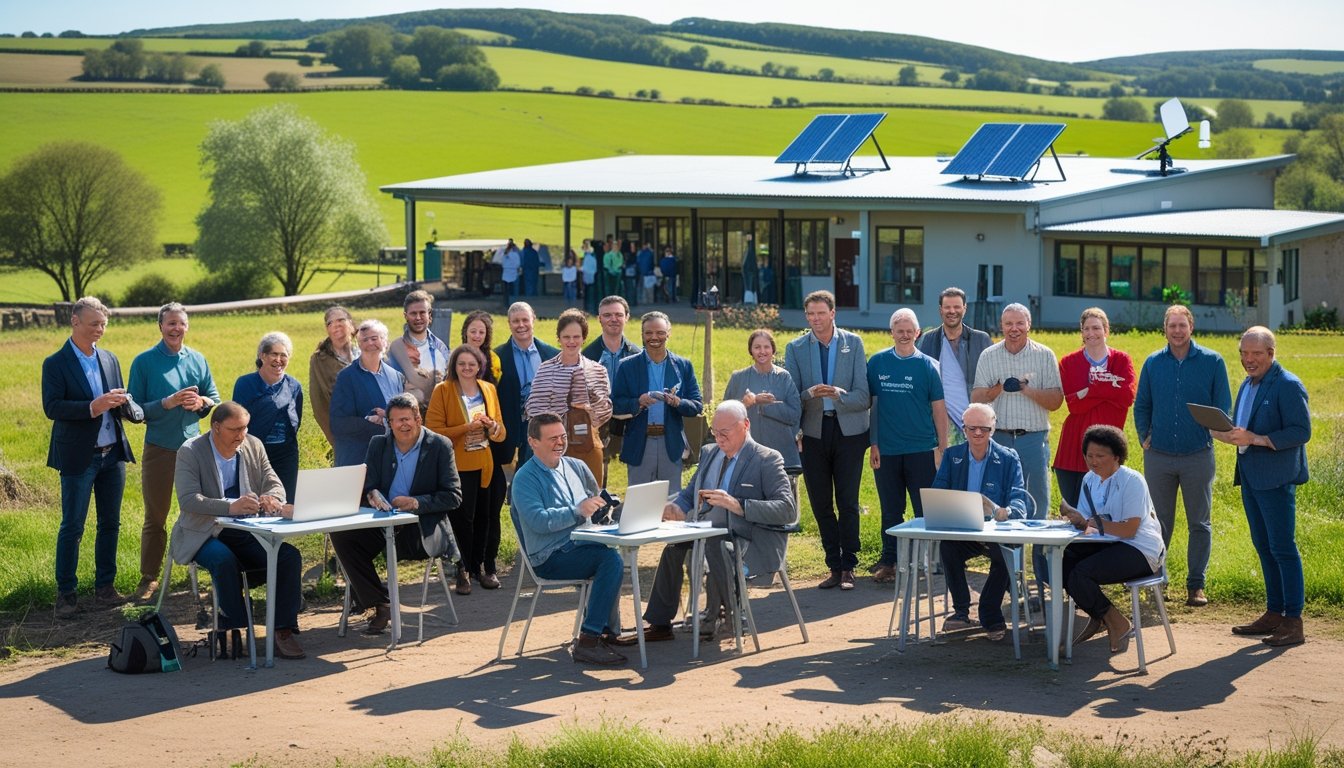Late updated: 10 Oct 2025 10:10
Written by: Oliver Bennett
Digital Inclusion Strategies For A Connected Countryside: Empowering Rural Communities
In today's digital age, ensuring that rural communities are not left behind is a priority we cannot overlook. Digital inclusion in these areas is not merely about providing internet access. It's about creating an environment where individuals can thrive by having equal opportunities to learn, work, and participate in an economy increasingly driven by technology. The integration of digital skills training, accessible internet services, and affordable devices holds the key to transforming the countryside into a hub of connectivity and growth.

Our journey through digital inclusion strategies explores methods to bridge this gap effectively. By focusing on initiatives such as building robust internet infrastructure and introducing community-focused digital skills programs, we aim to pave the way for real change. Communities stand to benefit not only from increased connectivity but also from the empowerment that comes with digital knowledge and proficiency.
We believe in the power of collective action and innovation. As technology evolves, so should our strategies to include everyone, irrespective of their location. Join us as we dive into practical solutions and insights, charting a path towards a more connected countryside.
Key Takeaways
- Digital inclusion goes beyond access to the internet.
- Building infrastructure and skills is fundamental.
- Collective efforts drive innovation and community growth.
Core Digital Inclusion Strategies for a Connected Countryside
In tackling digital inclusion within rural communities, we address significant challenges and seize opportunities. Effective strategies encompass improving infrastructure, ensuring affordable access, and fostering digital skills, all aimed at bridging the rural digital divide.
Understanding the Rural Digital Divide
The rural digital divide represents the gap between rural and urban areas in terms of access to technology and internet services. Many rural communities face limited connectivity options, affecting their ability to participate in the digital economy. Factors such as sparse population and challenging geography contribute to this divide, making it important for us to focus on tailored solutions.
Analysing these unique obstacles allows us to identify and implement strategies that specifically target rural needs. Understanding the digital disparities involves examining local conditions and user requirements.
Improving Connectivity and Infrastructure
A robust digital infrastructure is crucial for connecting rural areas. Investment in broadband expansion, such as fibre-optic cables and wireless networks, can significantly enhance connectivity. Encouraging partnerships between government, private sector, and local communities enables resource sharing and leverages expertise. Reliable mobile networks also play a vital role in ensuring connectivity across remote locations.
Innovative solutions like satellite internet and public Wi-Fi hotspots can overcome geographical barriers. These efforts expedite the deployment of essential infrastructure, helping us close the gap between urban and rural digital access.
Affordable Devices and Sustainable Access
Ensuring access to affordable devices is vital for digital inclusion in rural areas. Cost-effective tablets, laptops, and smartphones provide the tools necessary for accessing online services. We can work with manufacturers and retailers to offer subsidies or discounts for devices, making them more accessible to rural residents.
Sustainable access also depends on ongoing support and maintenance. Establishing local service centres and repair workshops helps keep devices operational over time, ensuring long-term connectivity and usability.
Building Digital Skills and Literacy
Digital skills and literacy are essential for utilising technology effectively. Training programmes tailored for rural communities should cover basic and intermediate digital skills, empowering residents to engage with digital platforms confidently. Workshops, online courses, and peer mentoring initiatives can foster a culture of continuous learning.
It's important to involve schools, libraries, and community centres as hubs for knowledge sharing. By equipping individuals with the skills needed for digital navigation, we enable them to take full advantage of online opportunities, thus narrowing the digital divide.
Bold actions and collaborative efforts are required to achieve digital inclusion in the countryside. By implementing these tailored strategies, we can ensure that all rural residents have the opportunity to thrive in a connected world.
Fostering Community Engagement and Harnessing Innovative Technologies

Engaging rural communities and integrating innovative technologies are pivotal for boosting digital inclusion in the countryside. Key focus areas include community-led approaches, the use of AI for rural development, and creating supportive policy frameworks.
Effective Community-Led Approaches
Community-led initiatives pave the way for rapid and sustainable digital inclusion. By empowering local groups to take charge, we ensure that solutions are tailored to meet specific needs. One successful approach is the formation of digital hubs, which serve as centres for learning and technological access. These hubs can provide training sessions, workshops, and support groups focusing on digital literacy.
Such initiatives amplify the voices within rural communities, ensuring that their unique challenges are addressed. Additionally, involving community leaders in decision-making processes builds trust and encourages wider participation. It is crucial to integrate cultural norms and existing community structures to ensure seamless adoption and participation. Local knowledge becomes the bedrock on which effective digital inclusion strategies are built.
Leveraging AI for Rural Advancement
Artificial Intelligence (AI) holds transformative potential for rural areas, offering solutions to enhance productivity and daily life. By deploying AI-driven tools, agricultural practices can be optimised through predictive analytics, which support better crop management and resource utilisation. For instance, AI can analyse weather patterns to advise farmers on optimal planting times.
In healthcare, AI-powered platforms can expand access to medical expertise through telemedicine, reducing the need for long-distance travel. Furthermore, AI can streamline logistics, improving supply chains for local businesses. By understanding community-specific needs, AI adoption can be tailored to deliver maximum benefits. It is vital to ensure that AI technologies are made accessible and user-friendly for rural populations.
Policy, Partnerships, and Ongoing Support
Robust policies and strategic partnerships are essential for sustaining digital inclusion efforts. Government action plans should include funding opportunities and incentives for technological adoption in rural areas. Collaborations with non-profits, private sector players, and local authorities can aid in resource allocation and ensure comprehensive coverage.
Long-term commitment is key. Efforts must be backed by continuous support and timely updates to policies to adapt to evolving technological landscapes. Creating feedback loops with rural communities can help in refining strategies and ensuring they remain relevant. By fostering partnerships and supporting policies, we lay a strong foundation for enduring digital growth in the countryside.
Frequently Asked Questions

Digital inclusion in rural areas involves several strategies and challenges. We explore measures for improving high-speed internet access, increasing digital literacy, leveraging sustainable technologies, fostering public-private partnerships, and overcoming barriers to connectivity.
What are effective measures to ensure rural areas have access to high-speed internet?
Access to high-speed internet in rural areas can be ensured through government funding for infrastructure projects and the deployment of fibre-optic cables. Satellite internet and community broadband initiatives also play a significant role in these efforts.
In what ways can digital literacy be improved among countryside communities?
To boost digital literacy, we can organise workshops and training programmes that target different age groups. Schools contribute by integrating digital tools into their curriculum. Libraries and community centres serve as local hubs for digital learning resources, enabling people to gain essential skills.
Which technologies provide the most sustainable and cost-effective solutions for rural connectivity?
Technologies like satellite internet offer broad coverage with minimal infrastructure. Wireless broadband and mobile networks are also effective, providing flexibility and affordability. Investing in these technologies ensures sustainable connectivity in remote regions.
What role do public-private partnerships play in advancing digital inclusivity in less urbanised regions?
Public-private partnerships are crucial in bridging the digital divide. Government entities collaborate with tech companies to roll out infrastructure and offer subsidised services. These partnerships enhance resource availability and innovation for better digital access.
How can governments support digital infrastructure development in sparsely populated areas?
Governments can support rural digital infrastructure by offering grants and subsidies, lowering barriers to entry for internet service providers. Policies that encourage competition further strengthen connectivity efforts. Additionally, investing in research for innovative technologies can drive development.
What are the main barriers to digital inclusion for residents in remote locations and how can they be overcome?
Key barriers include limited infrastructure investment and high service costs. These can be addressed through focused government policies and community-driven initiatives. Partnerships with tech firms can introduce cost-effective solutions. Access to digital education also plays a vital role in overcoming these challenges.
